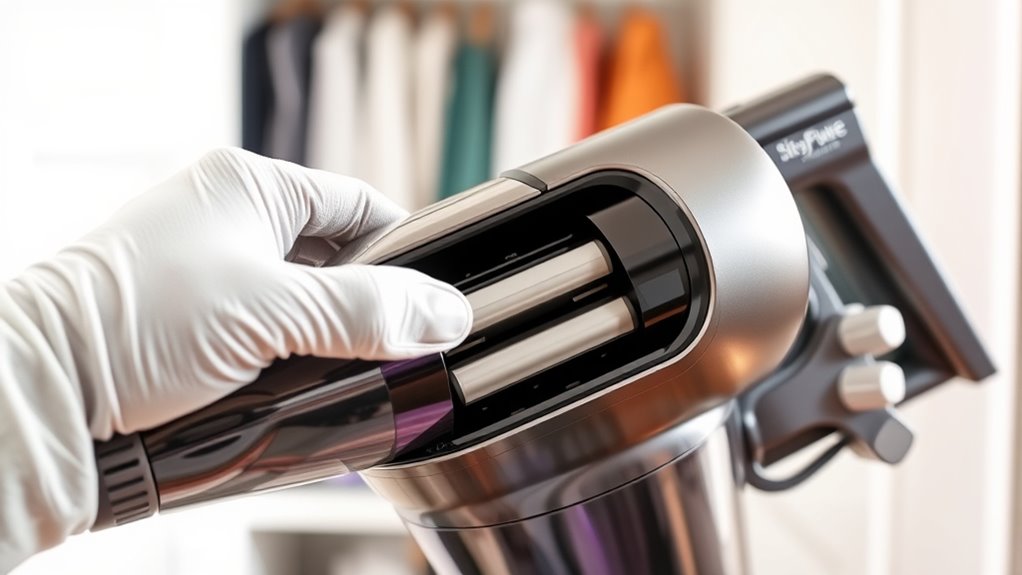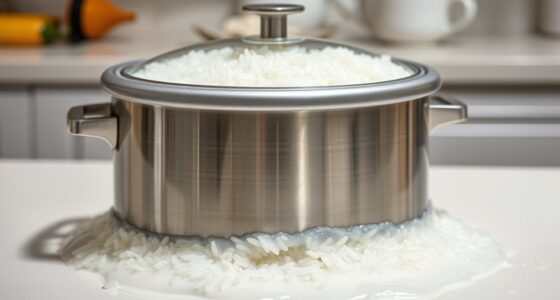To make your handheld vacuum’s battery last longer, always use the correct charger and avoid overcharging or deep discharging. Store it in a cool, dry place, and disconnect the battery during long periods of inactivity. Keep contacts clean and vents free of dust to prevent overheating. Regularly check for signs of wear, like shorter run times or longer charges, and replace the battery when needed. Learning more will help you keep your vacuum performing at its best.
Key Takeaways
- Use the correct charger and unplug once fully charged to prevent overcharging and overheating.
- Store the vacuum in a cool, dry place away from direct sunlight to preserve battery health.
- Regularly clean battery contacts and vents to ensure good connections and prevent overheating.
- Avoid deep discharges; recharge the battery before it completely runs out to extend lifespan.
- Monitor for signs of wear, like shorter run times or slow charging, and replace the battery when necessary.
Understanding Your Vacuum’s Battery Type
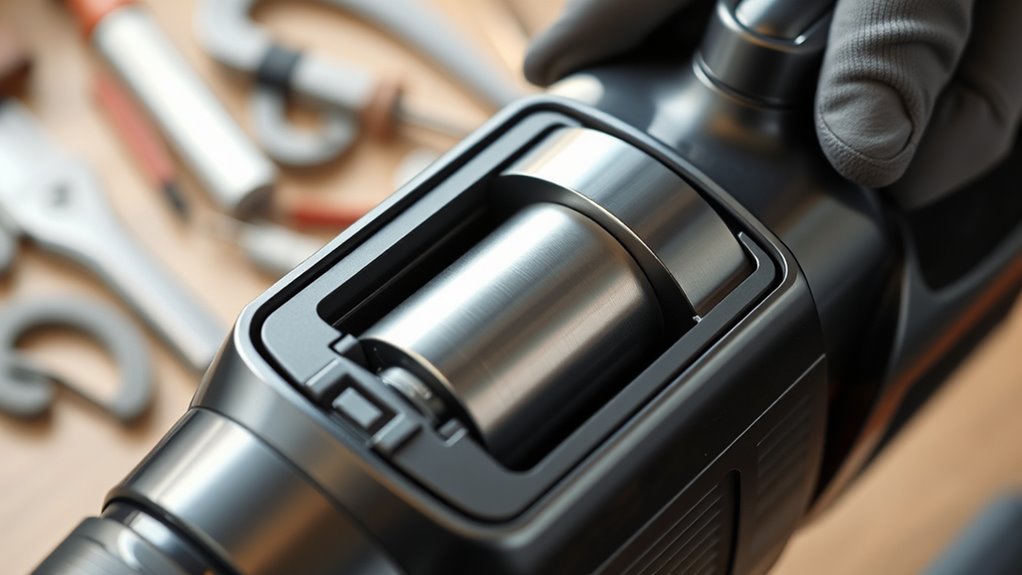
Have you ever wondered what kind of battery powers your handheld vacuum? Understanding your vacuum’s battery chemistry is key to keeping it in top shape. Most models use lithium-ion batteries, which are known for their high energy density and long lifespan. Unlike older nickel-based batteries, lithium-ion batteries are sensitive to charging cycles, which are the number of complete charge and discharge processes they can handle before their capacity starts to decline. Knowing your battery type helps you avoid overcharging or deep discharging, both of which can shorten its life. Proper battery maintenance can significantly extend the overall lifespan of your vacuum’s power source. By understanding these basics, you’ll be better equipped to care for your vacuum’s battery and ensure it performs efficiently for as long as possible.
Proper Charging Techniques for Longevity
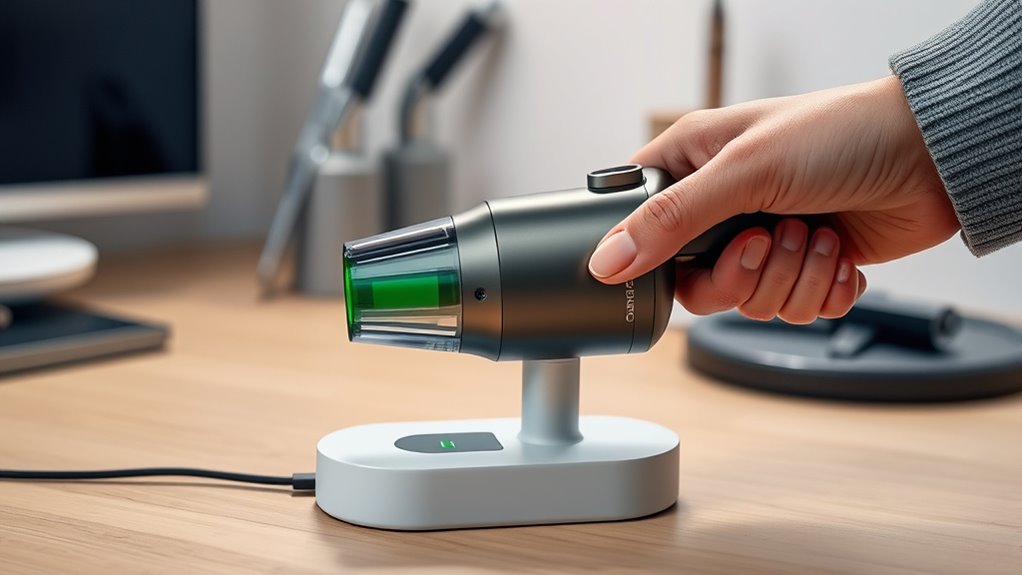
To keep your handheld vacuum’s battery in top shape, always use the correct charger designed for it. Avoid leaving it plugged in overnight or for extended periods, as overcharging can damage the battery. Charge in a cool, dry place to prevent overheating and guarantee ideal battery life.
Use Correct Charger
Using the correct charger is essential to extending the lifespan of your handheld vacuum’s battery. A charger that matches your device’s battery capacity guarantees efficient charging without risking damage. Always check for charger compatibility; using an incompatible charger can lead to reduced battery life or failure. Ensuring the charger meets industry standards helps maintain safety and performance.
Avoid Overcharging Periods
Avoid overcharging your handheld vacuum’s battery by unplugging it once it reaches full capacity. Constantly leaving it plugged in can lead to battery overheating, which accelerates capacity loss over time. To maximize battery lifespan, limit the charging cycle frequency—don’t charge unnecessarily or keep it plugged in overnight. Modern batteries are designed to stop charging once full, but prolonged overcharging can still cause heat buildup and stress the cells. Regularly monitor the charging process and unplug once the indicator shows full charge. This simple step reduces the risk of overheating and minimizes wear on the battery. Additionally, understanding how high refresh rates enhance performance can help you optimize your device’s longevity and efficiency. By adopting these proper charging habits, you’ll help ensure your handheld vacuum’s battery stays healthy and lasts longer.
Charge in Cool Environment
Charging your handheld vacuum’s battery in a cool environment helps prevent overheating and prolongs its lifespan. When the battery temperature stays lower during charging, it reduces stress on the cells and minimizes wear over time. Avoid charging in hot or humid spaces, as excessive heat accelerates battery degradation. A cool, dry environment ensures the battery remains within safe temperature ranges, helping it maintain ideal performance. If your charging area gets warm, consider moving your vacuum to a cooler spot or using a fan. Consistently charging in a cool environment supports healthy battery chemistry, improves charge retention, and extends overall battery life. Keep your charging station well-ventilated and free from heat sources for the best results. Proper charging conditions also contribute to better battery health and longevity.
Tips for Storing Your Handheld Vacuum When Not in Use
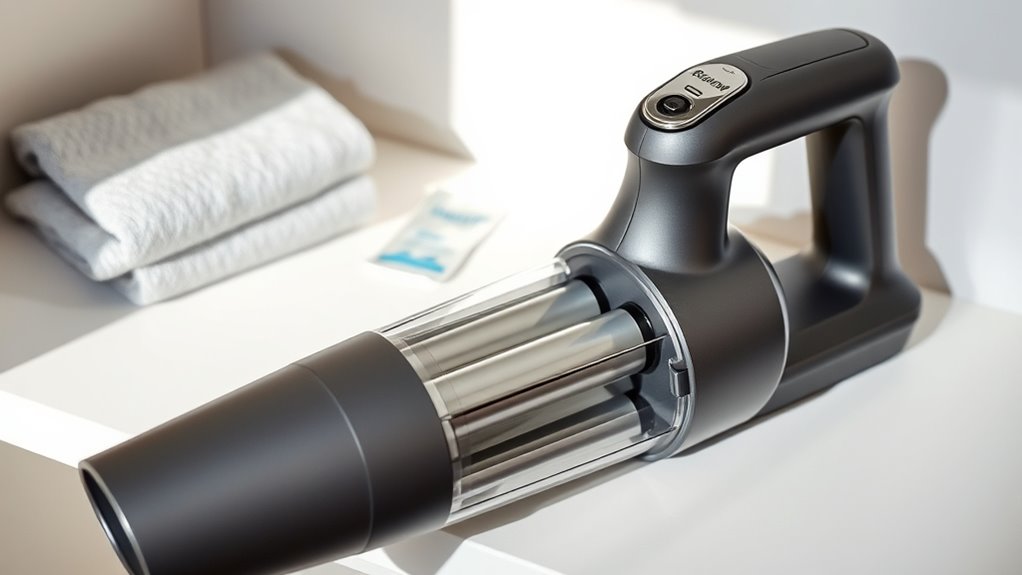
When you’re not using your handheld vacuum, storing it properly helps maintain its battery life. Make sure to keep it in a cool, dry environment away from direct sunlight. Also, consider disconnecting the battery if you’ll be storing it for a long period to prevent unnecessary drain. Regularly inspecting and following manufacturer guidelines can further prolong the battery’s effectiveness. Battery care
Proper Storage Environment
Storing your handheld vacuum in the right environment helps maintain its battery health and prolongs its lifespan. Proper storage conditions, especially temperature control, are essential. Avoid areas with extreme heat or cold, as temperature fluctuations can damage the battery cells. Instead, keep your vacuum in a cool, dry place where it won’t be exposed to direct sunlight or moisture. Ensuring stable temperature conditions prevents unnecessary strain on the battery, reducing capacity loss over time. Regularly checking the battery’s condition can help identify early signs of degradation and ensure optimal performance. Here are some tips for ideal storage:
- Store in a cool, dry spot away from direct sunlight
- Keep it in a climate-controlled area with consistent temperature
- Avoid storing in places with high humidity or temperature swings
Battery Disconnection Tips
To keep your handheld vacuum’s battery in top condition during periods of inactivity, disconnect the battery if possible. Removing the battery helps prevent self-discharge and potential damage from remaining power. Before disconnecting, check if your device’s battery is recyclable; proper battery recycling ensures environmental safety and may be required by local regulations. Keep the disconnected battery in a cool, dry place away from metal objects that could cause short circuits. If your vacuum has a battery warranty, disconnecting and storing the battery properly can help maintain that warranty, especially if damage occurs due to improper storage. Regularly inspect the battery for signs of deterioration, and always follow manufacturer instructions for disconnection and storage to extend your vacuum’s lifespan. Understanding vetted product information can also help you select high-quality batteries that last longer and perform better.
Avoiding Common Mistakes That Damage Batteries
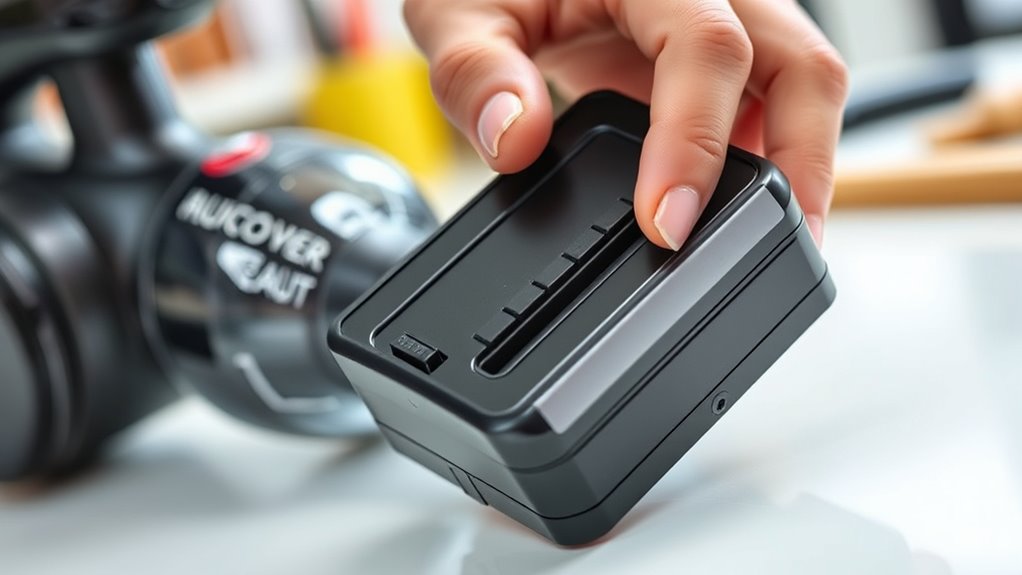
Avoiding common mistakes that damage your handheld vacuum’s battery is essential for maintaining its performance and longevity. One mistake is ignoring proper battery recycling options, which can harm the environment and reduce battery efficiency over time. Another is charging the device too quickly; high charging speeds can cause overheating and degrade the battery faster. Keep an eye on how long you leave your vacuum plugged in, as overcharging can lead to capacity loss. Additionally, avoid using incompatible chargers, which may supply incorrect voltage and damage the battery. Being mindful of these issues helps extend your vacuum’s lifespan. Remember, proper charging practices and responsible recycling are key to preventing damage and ensuring your battery stays in top shape longer. Proper privacy and cookie management also plays a role in maintaining optimal device performance and user safety.
Regular Maintenance and Cleaning for Optimal Performance

Regular maintenance and cleaning are crucial for keeping your handheld vacuum’s battery performing at its best. Regularly check and clean the battery contacts to guarantee a solid connection, preventing performance issues. Keep the vents free of dust and debris to improve airflow and avoid overheating, which can shorten battery life. Properly recycling your old batteries through certified battery recycling programs supports environmental health and ensures safe disposal. Additionally, understanding your warranty coverage can protect you if your battery malfunctions prematurely. Follow the manufacturer’s guidelines for cleaning and maintenance to preserve warranty rights. Taking these simple steps prolongs your battery’s lifespan, maintains ideal suction power, and helps you avoid unnecessary replacements, saving you money and hassle in the long run. Regular inspections can also help identify signs of wear early, preventing more serious issues down the line and consistent maintenance practices are essential for optimal appliance performance.
Recognizing Signs of Battery Wear and When to Replace
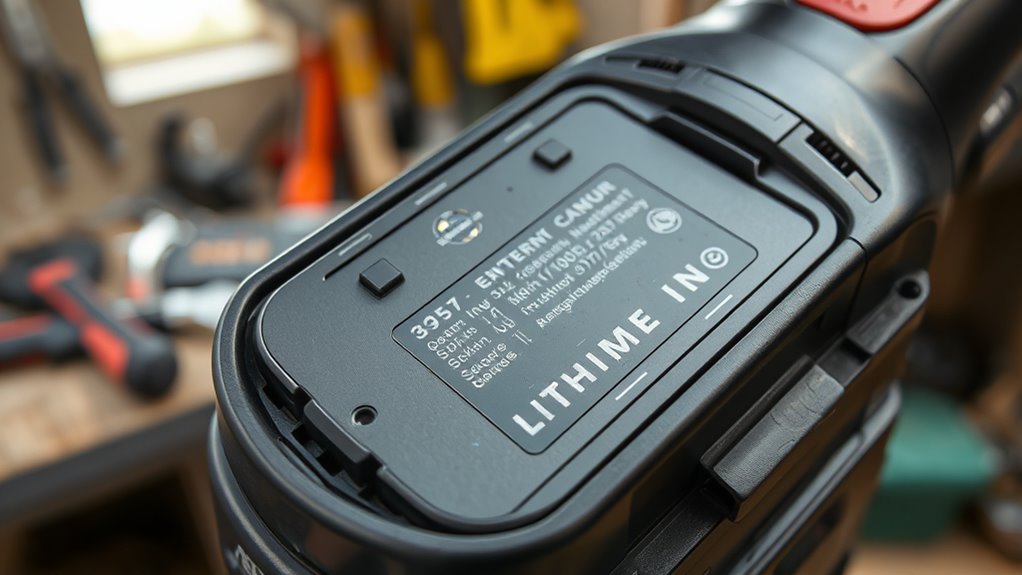
Recognizing when your handheld vacuum’s battery is wearing out is essential for maintaining peak performance. As the battery ages, you’ll notice signs like shorter run times, which indicate a capacity decline after multiple battery cycles. Additionally, the vacuum may take longer to charge or stop holding a charge altogether, signaling it’s time for a replacement. Keep an eye out for these clues:
- Reduced cleaning time despite a full charge
- The vacuum’s power drops quickly during use
- Charging takes longer or fails to reach full capacity
- Battery longevity can be affected by usage patterns and storage conditions, impacting overall performance.
These signs show your battery’s capacity decline and suggest it’s nearing the end of its lifespan. Replacing the battery before complete failure ensures your vacuum continues to perform efficiently and avoids frustration.
Frequently Asked Questions
How Often Should I Fully Discharge and Recharge My Handheld Vacuum Battery?
You should fully discharge and recharge your handheld vacuum battery about once every 3 to 5 months to maintain peak performance. This process, known as battery calibration, helps your device’s battery gauge stay accurate. Avoid frequent deep discharges, as they can reduce battery life. Instead, aim for regular charging cycles, keeping the battery between 20% and 80%, which preserves its capacity and extends its lifespan.
Can Using a Different Charger Harm My Vacuum’s Battery Health?
Using a different charger can definitely harm your vacuum’s battery health if it’s not compatible. It’s like fitting a square peg in a round hole—charger compatibility matters. An incompatible charger might cause overcharging or undercharging, reducing battery life or even damaging it. If your battery eventually needs replacement, using the right charger helps prolong its lifespan. Always use the original or a certified compatible charger to keep your vacuum running smoothly.
What Environmental Conditions Are Best for Battery Storage?
You should store your vacuum’s battery in a cool, dry place with ideal temperature between 50-77°F (10-25°C). Keep storage humidity low to prevent corrosion and damage. Avoid extreme heat or cold, as these conditions can degrade the battery’s health. Make sure it’s stored in a place with stable temperature and low humidity to prolong battery life and guarantee it’s ready for use whenever needed.
How Do Temperature Fluctuations Affect Battery Lifespan?
Temperature fluctuations can gently challenge your battery’s lifespan, often leading to thermal expansion and contraction that stresses its components. This subtle dance accelerates battery degradation over time, reducing its capacity and efficiency. To keep your handheld vacuum’s battery healthy, avoid exposing it to extreme or rapidly changing temperatures. Keeping it in a stable, moderate environment helps prevent unnecessary wear, ensuring your device stays powerful and ready when you need it most.
Is It Safe to Leave My Vacuum Plugged in After Charging?
It’s generally safe to leave your vacuum plugged in after charging, but good battery safety practices suggest unplugging it once fully charged. Consistently maintaining proper charging habits helps prevent overheating and prolongs battery life. Avoid leaving it plugged in for extended periods, as it can stress the battery and reduce its lifespan. By following these charging habits, you guarantee your vacuum’s battery stays healthy and performs at its best over time.
Conclusion
By caring for your handheld vacuum’s battery, you’re nurturing a loyal companion that works tirelessly for you. Treat its power with kindness, and it’ll reward you with lasting strength and performance. Think of it as tending a delicate garden—regular attention and gentle handling keep everything thriving. When you cherish and maintain your vacuum’s battery, you’re not just prolonging its life; you’re ensuring every cleaning adventure feels like a fresh start, full of promise and purpose.
